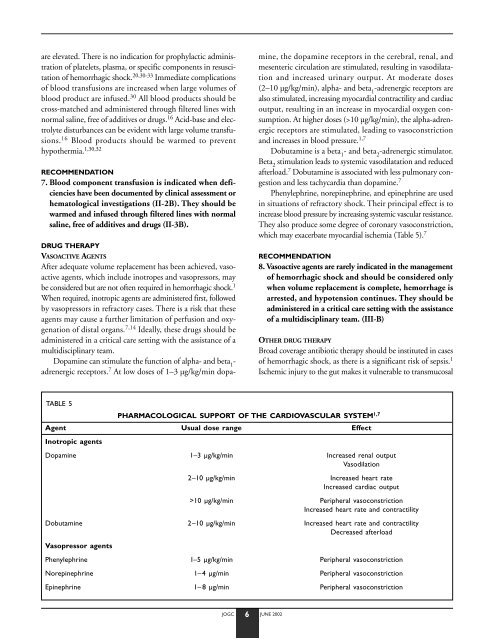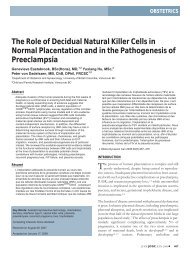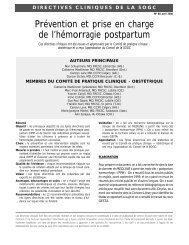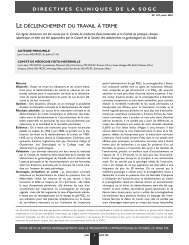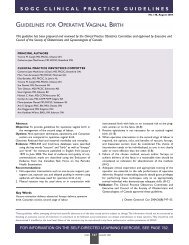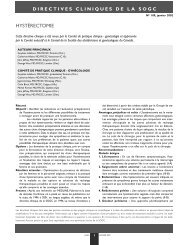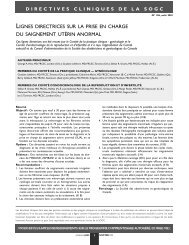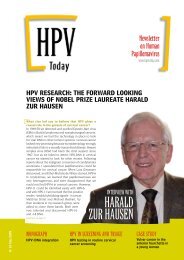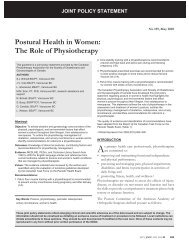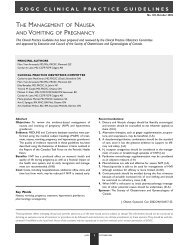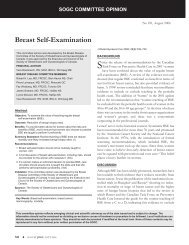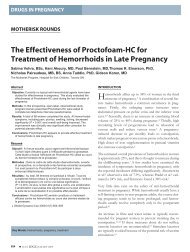Hemorrhagic Shock - SOGC
Hemorrhagic Shock - SOGC
Hemorrhagic Shock - SOGC
You also want an ePaper? Increase the reach of your titles
YUMPU automatically turns print PDFs into web optimized ePapers that Google loves.
are elevated. There is no indication for prophylactic administration<br />
of platelets, plasma, or specific components in resuscitation<br />
of hemorrhagic shock. 20,30-33 Immediate complications<br />
of blood transfusions are increased when large volumes of<br />
blood product are infused. 30 All blood products should be<br />
cross-matched and administered through filtered lines with<br />
normal saline, free of additives or drugs. 16 Acid-base and electrolyte<br />
disturbances can be evident with large volume transfusions.<br />
16 Blood products should be warmed to prevent<br />
hypothermia. 1,30,32<br />
RECOMMENDATION<br />
7. Blood component transfusion is indicated when deficiencies<br />
have been documented by clinical assessment or<br />
hematological investigations (II-2B). They should be<br />
warmed and infused through filtered lines with normal<br />
saline, free of additives and drugs (II-3B).<br />
DRUG THERAPY<br />
VASOACTIVE AGENTS<br />
After adequate volume replacement has been achieved, vasoactive<br />
agents, which include inotropes and vasopressors, may<br />
be considered but are not often required in hemorrhagic shock. 1<br />
When required, inotropic agents are administered first, followed<br />
by vasopressors in refractory cases. There is a risk that these<br />
agents may cause a further limitation of perfusion and oxygenation<br />
of distal organs. 7,14 Ideally, these drugs should be<br />
administered in a critical care setting with the assistance of a<br />
multidisciplinary team.<br />
Dopamine can stimulate the function of alpha- and beta1- adrenergic receptors. 7 At low doses of 1–3 µg/kg/min dopa-<br />
JOGC 6 JUNE 2002<br />
mine, the dopamine receptors in the cerebral, renal, and<br />
mesenteric circulation are stimulated, resulting in vasodilatation<br />
and increased urinary output. At moderate doses<br />
(2–10 µg/kg/min), alpha- and beta 1 -adrenergic receptors are<br />
also stimulated, increasing myocardial contractility and cardiac<br />
output, resulting in an increase in myocardial oxygen consumption.<br />
At higher doses (>10 µg/kg/min), the alpha-adrenergic<br />
receptors are stimulated, leading to vasoconstriction<br />
and increases in blood pressure. 1,7<br />
Dobutamine is a beta 1 - and beta 2 -adrenergic stimulator.<br />
Beta 2 stimulation leads to systemic vasodilatation and reduced<br />
afterload. 7 Dobutamine is associated with less pulmonary congestion<br />
and less tachycardia than dopamine. 7<br />
Phenylephrine, norepinephrine, and epinephrine are used<br />
in situations of refractory shock. Their principal effect is to<br />
increase blood pressure by increasing systemic vascular resistance.<br />
They also produce some degree of coronary vasoconstriction,<br />
which may exacerbate myocardial ischemia (Table 5). 7<br />
RECOMMENDATION<br />
8. Vasoactive agents are rarely indicated in the management<br />
of hemorrhagic shock and should be considered only<br />
when volume replacement is complete, hemorrhage is<br />
arrested, and hypotension continues. They should be<br />
administered in a critical care setting with the assistance<br />
of a multidisciplinary team. (III-B)<br />
OTHER DRUG THERAPY<br />
Broad coverage antibiotic therapy should be instituted in cases<br />
of hemorrhagic shock, as there is a significant risk of sepsis. 1<br />
Ischemic injury to the gut makes it vulnerable to transmucosal<br />
TABLE 5<br />
PHARMACOLOGICAL SUPPORT OF THE CARDIOVASCULAR SYSTEM1,7 Agent Usual dose range Effect<br />
Inotropic agents<br />
Dopamine 1–3 µg/kg/min Increased renal output<br />
Vasodilation<br />
2–10 µg/kg/min Increased heart rate<br />
Increased cardiac output<br />
>10 µg/kg/min Peripheral vasoconstriction<br />
Increased heart rate and contractility<br />
Dobutamine 2–10 µg/kg/min Increased heart rate and contractility<br />
Decreased afterload<br />
Vasopressor agents<br />
Phenylephrine 1–5 µg/kg/min Peripheral vasoconstriction<br />
Norepinephrine 1–4 µg/min Peripheral vasoconstriction<br />
Epinephrine 1– 8 µg/min Peripheral vasoconstriction


